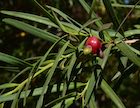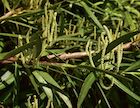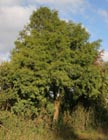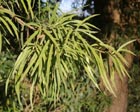
Foliage, twig, and an example of a ripe receptacle bearing two seeds. iNaturalist observation 145458601 [Jeff Bisbee, 2022.12].

Foliage, twig, and active pollen cones. iNaturalist observation 145458405 [Jeff Bisbee, 2022.12].

P. salignus in Valdivian rain forest at Parque Oncol, Chile [Rick Fencl, 2006.03].

Bark of a tree at Parque Oncol, Chile [Rick Fencl, 2006.03].

Foliage of a tree at Parque Oncol, Chile [Rick Fencl, 2006.03].

Podocarpus salignus
D. Don ex Lambert 1824
Common names
Mañio, manique [Chilean Spanish] (Farjon 2010); willow-leaf podocarp (Lambert 1824).
Taxonomic notes
Type: Chile, R. Ruiz & J.A. Pavon y Jimenez s.n. (holo BM). Syn: P. chilinus Rich. & A.Rich. ex A.Rich. 1826; Nageia chilina (Rich. & A.Rich.) F.Muell. 1876 (Farjon 1998).
Description
Dioecious trees to 20 m tall and 100 cm dbh, usually with a single bole but sometimes branching low; crown pyramidal in young trees, often becoming dense and broadly domed in maturity. Bark first thin, smooth, light brown, with age developing exfoliating strips and weathering to pale gray. Twigs slender, round, often drooping. Foliage buds globose within imbricate, ovate-triangular scales. Leaves short-petiolate, lustrous light green above, pale green below, lax, linear-lanceolate, straight or slightly falcate, 50-90 × 4-7 mm; upper midrib raised, <0.4 mm wide, fading toward apex; similar but continuous to apex on lower side; margins not stated; apex acute. Pollen cones axillary, sessile, solitary or in small groups, 25-30 × 1.5-2 mm, yellow. Seed cones axillary, solitary on 10-20 mm peduncles, ripe receptacle succulent, deep red to violet, 5-6 × 4-5 mm. Seeds 1(-2), oblique-ovoid, including epimatium 7-8 × 4-5 mm, green ripening reddish, with an obtuse crest (Farjon 2010).
Distribution and Ecology
Chile: Biobio, La Araucania, Los Lagos, Maule; at 20-1200 m elevation on soils derived from siliceous rock types. It occurs both in riparian forests within Mediterranean climate areas, and in moist ravines and moist uplands in the Andes. The Mediterranean climate areas, near the north limits of its range, include the Roble-Hualo forest type where dominant species include Nothofagus dombeyi, N. obliqua, N. nervosa, Peumus boldus, Persea lingue, Drimys winteri, Aextoxicon punctatum, Gevuina avellana, Myrceugenia exsucca and Laruelia sempervirens. The Andean moist ravines and moist uplands include areas where Podocarpus is a minor component of Nothofagus obliqua-dominated forest, and areas where Podocarpus forms pure stands known as mañihuales. Near its upper range limits, it is confined to south-facing slopes (Farjon 2010, Gardner 2013). Based on data from 12 collection localities, it grows at elevations of 630 ±250 m. Within its range, mean annual temperature is 10°C, with an average minimum in the coldest month of 1°C, and a mean annual precipitation of 1700 mm (Biffin et al. 2011, Table S5). Hardy to Zone 8 (cold hardiness limit between -12.1°C and -6.7°C) (Bannister and Neuner 2001). Like other species of Podocarpus, the seed is mainly disseminated by birds; most seed come ripe from February into April, but a smaller proportion ripens throughout the rest of the year (Gardner 2013).
The IUCN has assigned this species a conservation status of "Vulnerable" based on a fairly rapid population decline due largely to habitat loss as a result of wildfire and the conversion of native forests to forestry plantations, mainly Pinus radiata and Eucalyptus spp. The area of occupancy is uncertain, but there has likely been fragmentation of populations and disproportionate loss of some populations. The species does occur in some protected areas, but these constitute a very small fraction of the area of occupancy (Gardner 2013).
Remarkable Specimens
No data as of 2023.01.23.
Ethnobotany
Timber from this species is used locally in structures and the craft industry. It is also popular in horticulture, especially in areas of Europe that experience a mild winter climate, where it forms an attractive, bushy tree with dense, pendulous foliage (Farjon 2010). There are some well-documented ex situ conservation plantings in Europe, as well (Gardner 2013).
Observations
The species is probably most easily found within reserve areas, which include the coastal Reserve Nacional Los Ruiles (Región VII) and the Parque Oncol (Región X); and one location in the Andes in Reserva Forestal Malleco (Región IX). There are numerous good observations recorded on iNaturalist.
Remarks
The epithet means "similar to Salix", the willows.
Citations
Gardner, M. 2013. Podocarpus salignus. The IUCN Red List of Threatened Species 2013: e.T32030A2808753. https://dx.doi.org/10.2305/IUCN.UK.2013-1.RLTS.T32030A2808753.en, accessed 2023.02.04.
Lambert, Aylmer Bourke. 1824. A description of the genus Pinus, illustrated with figures, directions relative to the cultivation, and remarks on the uses of the several species. Vol. 2, p. 20. London: J. White. Available: Biodiversity Heritage Library, accessed 2023.02.04.
See also
The species account at Threatened Conifers of the World, which also has some good photographs.





